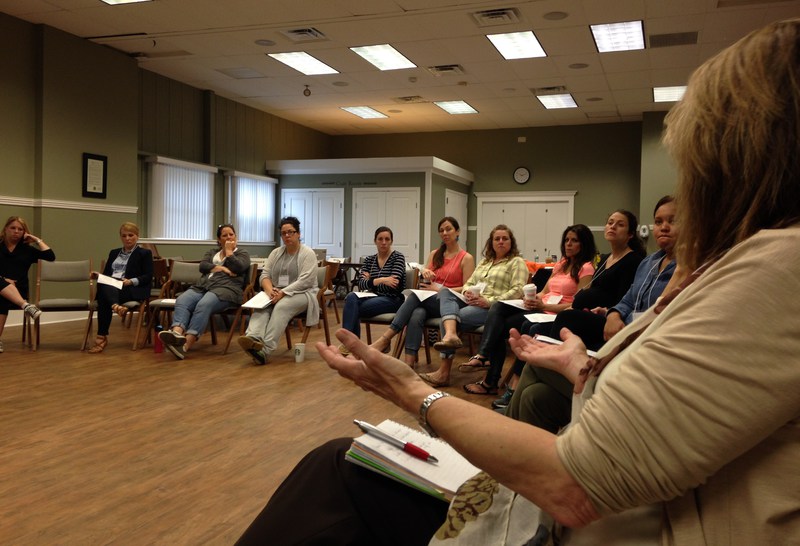
In May, (C3)2 grant participants-classroom teachers, special teachers and teaching artists-gathered to share and reflect on their arts-integrated learning experiences during the spring of 2016. A full-day Peer-to-Peer (P2P) session, also known as a Community of Practice workshop, was held for the Grade 4 and Grade 5 teams on separate days. (C3)2 project director Carol Brown and curriculum coordinator Laura Reeder asked participants to share what they had learned from the spring projects, how that experience compared with their arts-integrated projects in the fall, and how both projects might influence their decision-making in Year 2 of the grant.
To begin each day's exchange, Ms. Reeder (below) asked the group to consider "power words" that best described performance artist David Gonzalez and his retelling of the legend of Orpheus and Eurydice. Mr. Gonzalez's program, which was seen by all the (C3)2 teachers and their students, acted as a catalyst for the spring 2016 arts-integration projects. The teachers offered words like ''passionate,' 'risk-taking,' 'powerful,' and 'vivid.' Several teachers noted that Mr. Gonzalez had been a role model for their students. He had made the children more open-minded and more willing to take risks when working with the teaching artists. One teacher noted that Mr. Gonzalez's use of Spanish phrases in his performance had resonated with her Spanish-speaking students.

Afterwards, Ms. Reeder asked each project teams to describe how they had used Mr. Gonzalez's performance and their collaboration with a teaching artist to integrate art into a curriculum topic. The topics for the spring projects ranged from the parts of cells and geography to persuasive writing and performance poetry. As a group, the educators shared examples of student learning (ie, "more specific understanding of text," "great products from students with mixed abilities"), professional practices (ie, "better use of visual aids," teacher as a risk-taking role model"), engagement methods of the teaching artists (ie, "storyboard sequencing," "different ways to bring poetry to life"), and the projects' implementation of 21st Century skills and Core content (ie, "parts of a story," "citizenship").

Participants then worked as teams to create a PowerPoint presentation that summarized their spring project experience. Using the Pecha Kucha model, a format designed to keep presentations fast-paced and powerful, each team created a 10-slide presentation. "The Pecha Kucha format enables you to tell the story of learning," stressed Ms. Brown. "It is a way for others-teachers, administrators, parents-to understand why the arts-integrated process was important, and why you couldn't have achieved the same results without the performance and teaching artist's residency."
Each team worked with their teaching artist to created a Pecha Kucha that told their project's story, from the initial inquiry and exploration, to the discovery and reflection.

Teachers incorporated photographs of students, teachers and teaching artists collaborating on arts-integrated activities.


One team (below) created a new image to illustrate their project for the Pecha Kucha presenation. Below teaching artist Paul Rodriguez is blanketed with the project's storyboard illustrations.

Afterwards, each team shared their Pecha Kucha with the other teams (below).

During the afternoon sessions, participants reflected on the lessons learned during the grant's Year 1 of implementation and how those lessons might impact their planning and teaching in Year 2. Classroom teachers expressed the hope for better scheduling of time and the spaces used for art activities, more collaborations with special teachers, and more opportunities to learn about the projects being done by other (C3)2 schools.
A portion of the afternoon was also used by the teachers to complete Post-Year 1 student rubrics. The teachers had completed Pre-Year 1 student rubrics before the fall projects had begun. These documents, plus ongoing surveys, are part of the grant design's data collection. While the teachers were filling out the student rubrics, Ms. Brown (below, third from the left) and Ms. Reeder met with the teaching artists to share their thoughts about Year 1.

The P2P workshops wrapped up with Ms. Brown and Ms. Reeder touching on some of the plans and goals of the upcoming Summer Institute and the grant's Year 2 projects. "Next year, there will be a choice of performance," reported Ms. Brown. "As competency grows, classroom teachers will be making cultural choices and other choices."
